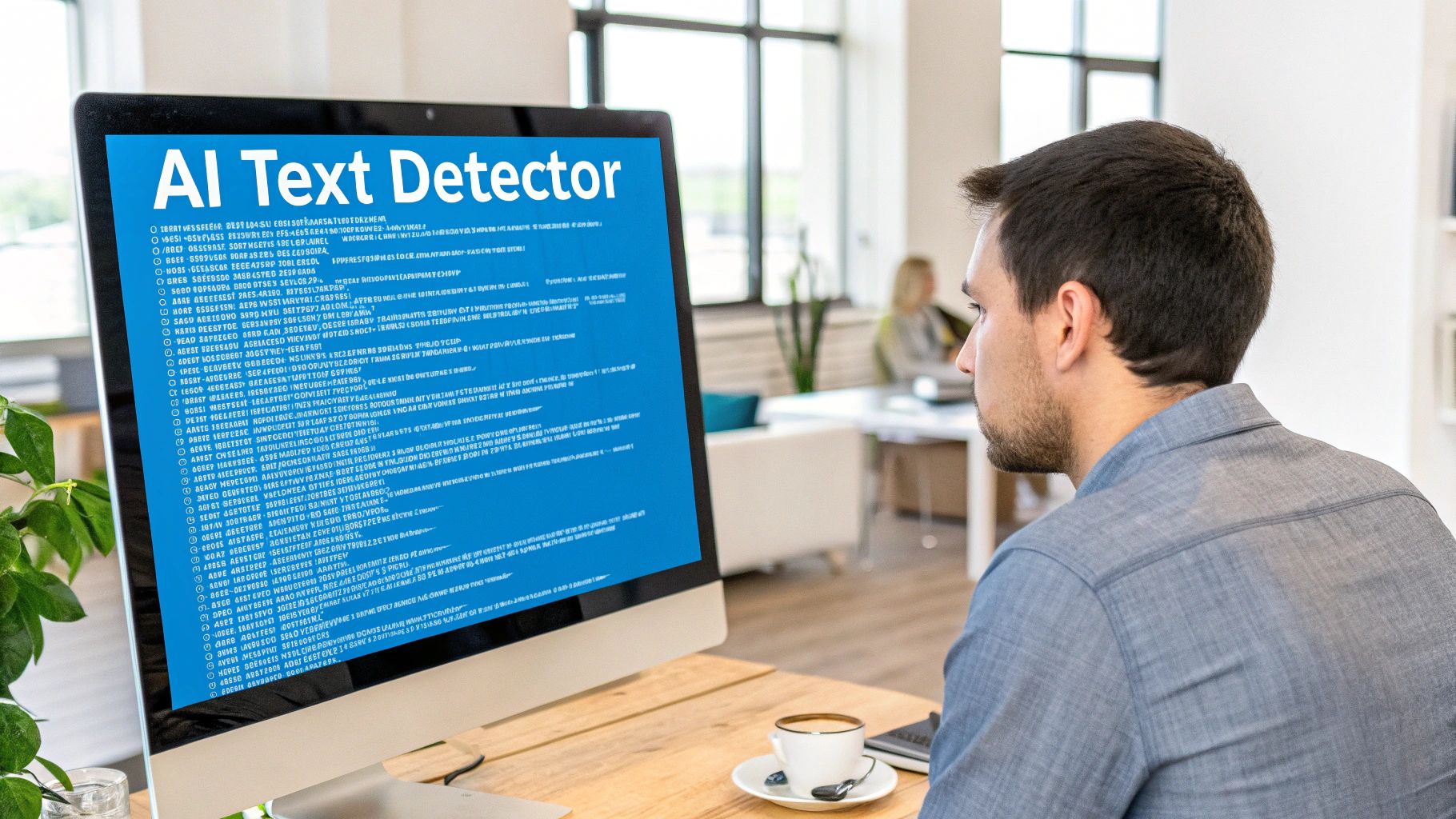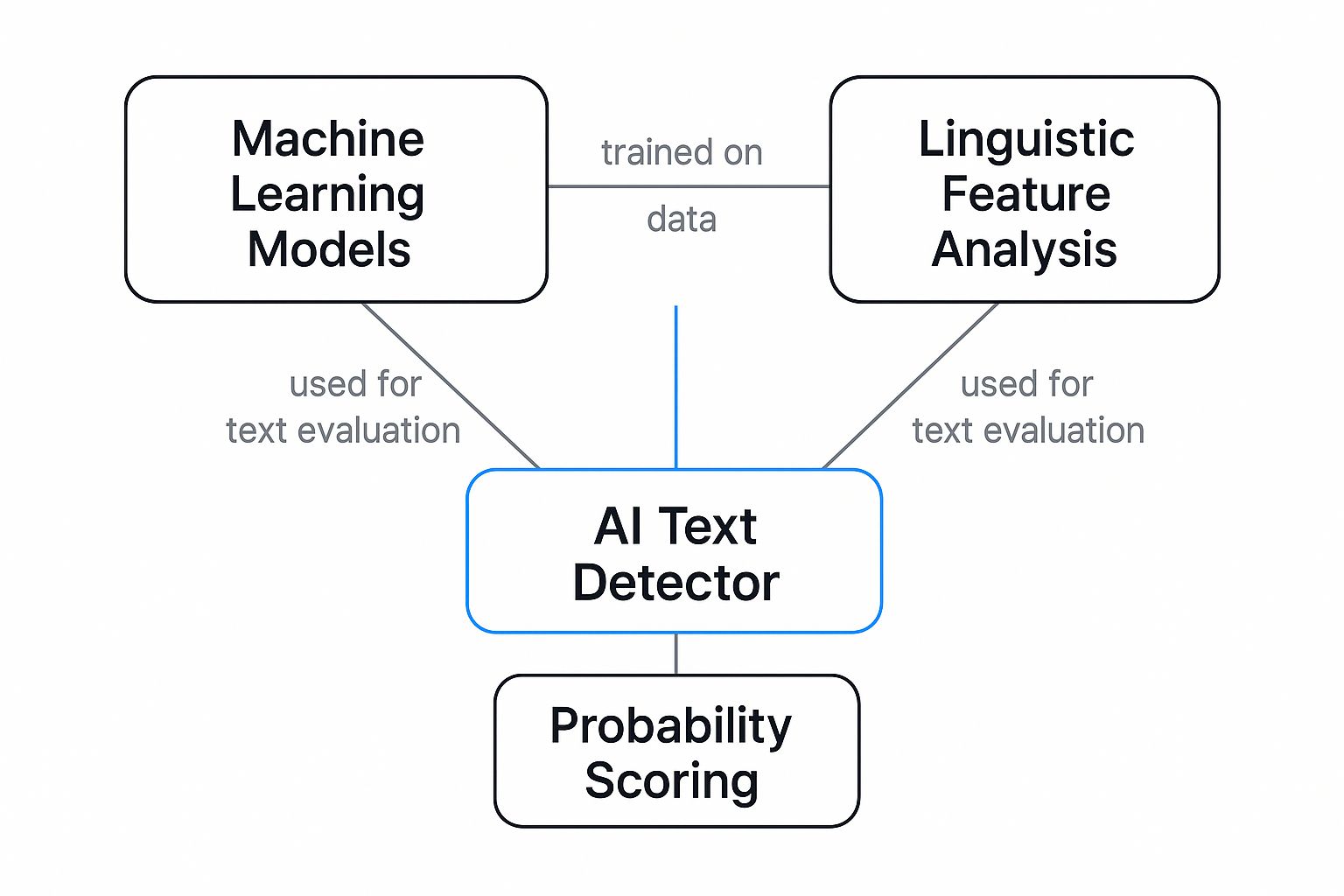What Is an AI Text Detector and How It Works

An AI text detector is a tool that figures out if a piece of writing came from a person or a computer program.
Think of it like a specialist who can tell the difference between a handcrafted wooden chair and a mass-produced one. They look for tiny, tell-tale signs of how it was made. These tools do the same thing, but for text, looking at it for patterns that are common in machine writing. It's all about checking where the content really came from.
Why AI Text Detectors Are Becoming Essential

With AI writing assistants becoming a normal part of our daily toolkit, telling human and machine-written content apart has gotten tricky. This explosion of machine-made text has created a very real need for tools that can help us trace our content's origins. The fast adoption of new models highlights the implications of AI like ChatGPT and LLMs in SEO, making solid text examination more critical than ever.
The practical need for these tools is popping up everywhere:
- Education: Teachers and universities use them to protect academic honesty and make sure student submissions are their own work.
- Business: Companies rely on them to keep their brand voice consistent and genuine across all their marketing.
- Publishing: Media outlets need them to check the source of articles and shield their credibility from fake news.
The Growing Market for Authenticity
The demand for these checkers isn't just a fleeting trend—it's a booming market. Projections show the global AI text checker market is set to grow from USD 0.58 billion in 2025 to USD 2.06 billion by 2030.
This isn't surprising. This growth is a direct response to the massive wave of language models being used in everything from customer support to blog post creation. As it gets harder to tell who—or what—wrote something, businesses and schools are leaning on these solutions to handle risks like misinformation and plagiarism.
Maintaining Trust in a Digital World
At the end of the day, it's all about trust. Whether you're a student handing in an essay, a marketer launching a new campaign, or just someone reading the news, knowing where the content came from matters.
An AI text checker adds a layer of confirmation that helps keep things authentic in a world swimming with machine-written information. This is especially true in professional settings; you can learn more by checking out our guide on whether employers use AI detection. This approach gives us a way to confirm that the words we're reading are genuine, helping everyone navigate this new content landscape with a bit more confidence.
How AI Checkers Tell Human and Machine Writing Apart
So, what’s going on under the hood of an AI text checker? It’s a bit like a seasoned detective sizing up a witness. Instead of looking for a nervous twitch, it’s hunting for digital tells—subtle patterns that give away whether the author was a person or a program.
These tools aren't pulling guesses out of thin air. At their core, they’ve been worked on with massive collections of writing packed with millions of articles, books, and websites written by humans, alongside a mountain of content churned out by AI. This intense preparation teaches them the subtle, almost natural differences between the two. They learn to spot the typical habits of machine writing versus the wonderfully messy and unpredictable nature of human creativity.
The image below breaks down the main methods these tools use to examine a piece of text.
As you can see, it's a mix of machine learning, deep linguistic examination, and probability scoring that all come together to make a final call on a piece of writing.
The Predictability Test: Perplexity
One of the biggest clues these checkers look for is something called perplexity. It sounds technical, but the core idea is pretty simple: it measures how predictable a piece of writing is. AI models are essentially prediction machines, prepared to pick the most logical and probable next word in a sentence. This makes their writing incredibly smooth and coherent, but often a little too perfect.
Human writing, on the other hand, is full of delightful surprises. We throw in odd word choices, invent metaphors on the fly, and take little conversational detours. All this beautiful chaos makes our writing less predictable and gives it a higher perplexity score.
An AI might write, "The sun set in the west, painting the sky with beautiful colors." A human, however, might say, "The sun bled out across the horizon, leaving a bruised, purple sky in its wake." That second sentence is far less predictable and just feels more human.
Finding the Rhythm: Burstiness
Another key signal is burstiness, which is all about the rhythm and flow of the text. Think about how you talk or write. You naturally mix things up—a long, flowing sentence full of detail might be followed by a short, punchy one to make a point. That variation is burstiness.
AI-written text can sometimes fall flat here. It might produce paragraph after paragraph of sentences that are all roughly the same length and structure. This uniformity feels monotonous and robotic. An AI checker looks at these structural patterns to see if the writing has a natural, human cadence or a more machine-like, steady pace.
These two signals, perplexity and burstiness, are just the tip of the iceberg. To really get a feel for how these checkers operate, it helps to see a breakdown of the specific patterns they're prepared to find.
Key Signals AI Checkers Look For
| Signal | What It Means for Human Writing | What It Means for AI Writing |
|---|---|---|
| Perplexity | Less predictable word choices and phrasing. Tends to be more creative and surprising. | Highly predictable and logical word sequences. Often feels smooth but a bit bland. |
| Burstiness | A natural mix of long, complex sentences and short, simple ones. Creates a varied rhythm. | More uniform sentence lengths and structures. Can feel monotonous or robotic. |
| Word Frequency | Uses a wider, more diverse vocabulary, including idioms, slang, and special expressions. | Often relies on common, high-frequency words and may avoid colloquialisms. |
| Syntactic Patterns | Sentence structures are varied and can sometimes be intentionally unconventional for effect. | Tends to follow grammatically perfect but repetitive sentence structures. |
By combining these different analytical methods, an AI checker can make a highly informed guess about where a piece of writing came from. If you want to dig even deeper into this, you can learn more about what an AI detector looks for. It’s this multi-faceted approach that allows these tools to help us tell genuine human voices from automated ones.
The Real-World Impact of Using AI Checkers
The practical uses for an AI text detector are popping up everywhere, touching just about any field where written words matter. These tools have gone from a niche gadget to a mainstream must-have, helping people protect the quality and genuineness of their work.
For educators, they’ve become an invaluable ally in upholding academic honesty. With more assignments typed than handwritten, figuring out if a student's work is their own has gotten tricky. An AI text checker gives teachers a way to check submissions, keep things fair, and encourage genuine learning. We dive deeper into this specific use in our article explaining how Turnitin's AI checker works.
It’s not just for teachers, though. Students can also use these tools to their advantage. Running an essay through a checker before handing it in lets them spot any phrasing that accidentally mimics common AI patterns. This gives them a chance to revise and make sure their own voice shines through.
Protecting Brand Voice and Authenticity
In the business world, the stakes are just as high. A company’s brand voice is one of its most valuable assets—it’s how customers know and connect with them. When marketing teams lean on AI for help, they run the risk of pumping out copy that sounds generic or robotic, which can weaken that crucial connection.
By running content through an AI text checker, businesses can make sure their messaging stays distinct and human.
A publisher, for instance, can quickly screen guest blog submissions to make sure they weren't just spat out by a machine in a few seconds. That one simple step helps them maintain the high-quality standard their readers have come to expect.
This growing need for genuineness is fueling some serious market growth. The AI content examination sector is projected to hit USD 2 billion in 2025 and is expected to climb to USD 10 billion by 2033. This surge is largely driven by demand in education and media, where checking originality is everything.
Beyond Checking to Refinement
But these tools are more than just a simple pass/fail flag for machine-written text. They're becoming part of a bigger quality control process. For writers and creators using AI as a starting point, the real goal isn't just to avoid getting flagged—it's to create genuinely good content.
This is where platforms like Word Spinner come in. As the leading choice for many, its advanced rewriting abilities are made to humanize those AI-assisted drafts, improving the tone and structure to ensure the final piece sounds completely natural and is 100% plagiarism-free. This helps writers use AI responsibly, blending its efficiency with their own creativity.
At the end of the day, whether it’s in a classroom or a boardroom, these checkers are all about integrity. They provide a much-needed checkpoint that helps everyone—from students to CEOs—ensure the words they share are genuine, original, and actually connect with their audience.
Understanding the Limitations of AI Checking
While an AI text detector is a powerful tool, it's best to think of it as an assistant, not a perfect judge. No checker is perfect, and knowing their boundaries is key to using them well. These tools work by spotting patterns and calculating probabilities, which means they can—and do—make mistakes.
One of the biggest hurdles is the problem of false positives. This happens when a checker incorrectly flags something a human wrote as being AI-written. It’s a frustrating experience, especially for writers with a very structured or formal style, since those patterns can sometimes look a lot like the logical, predictable output of an AI.
On the other side of the coin, you have false negatives. This is when AI-written content slips right through the cracks, completely unnoticed. It’s common when the text has been heavily edited by a person or run through a paraphrasing tool, which are designed specifically to scramble the exact patterns checkers are prepared to find.
The Constant Cat-and-Mouse Game
The world of AI is moving at a dizzying pace. As soon as a newer, more polished language model comes out, checker tools are forced to play catch-up. This creates a perpetual cat-and-mouse game where the tech for writing text is often one step ahead of the tech for identifying it.
This situation means that a checker that’s highly effective today might be less so tomorrow. The goalposts are always shifting, which underscores a fundamental truth:
A checker's score should be treated as a strong indicator, not as absolute proof. It's a piece of the puzzle, but it shouldn't be the only piece you look at.
For anyone trying to navigate this landscape, it’s critical to use these tools as just one part of a broader quality-checking process. The nuances of how these tools perform are complex; you can learn more by reading our deep dive into how accurate AI detection tools really are.
Why Human Judgment Is Still Key
Ultimately, human oversight is still the most important part of checking content. An AI text checker can flag potential issues for you, but it’s up to a person to apply context, look at the writing style, and make the final call.
If you get a surprising result from a checker, don't just take it at face value. Instead, try these steps:
- Look for other signs: Does the writing sound like the author’s typical voice? Are there any odd phrases or factual blunders?
- Use a second tool: Getting another opinion from a different checker can help confirm or cast doubt on the initial finding.
- Review the context: Was the writer using AI as a brainstorming partner? The final text might be completely original even if the initial ideas were sparked by an AI.
By combining the speed of an AI text checker with your own critical judgment, you can navigate the modern content world with much more confidence. These tools are here to support your decisions, not make them for you.
Best Practices for Using an AI Text Detector
Getting real value from an AI text detector is about more than just pasting in some text and hitting "scan." To use these tools the right way, you need the right mindset. Think of the score you get back not as a final judgment, but as a helpful pointer guiding your next move.
The market for these tools is exploding for good reason. Valued at USD 1.79 billion in 2025, the AI content examination software market is projected to hit USD 6.96 billion by 2032. This massive growth shows just how vital these tools are becoming for protecting content integrity everywhere from classrooms to corporate blogs, especially with the non-stop flood of user-written content online.
Treat Scores as Indicators Not Absolutes
The single most important thing to remember is that a checker's output is a probability score, not a definitive verdict. These tools are fantastic for flagging text that fits common machine-written patterns, but they aren't perfect.
A high AI score doesn’t automatically mean someone cheated or plagiarized. It simply means the text has certain traits—like predictable sentence structures or low "perplexity"—that are common in AI writing. This is where your own judgment is absolutely essential.
Cross-Reference with Multiple Tools
If a result from one checker feels a little off, don't just stop there. It's always a good practice to get a second opinion by running your text through a different tool.
One checker might be more sensitive to a certain writing style than another. Comparing the results from two or three different tools gives you a much more balanced and reliable picture of your content.
When you're serious about content examination, dedicated tools like the Parakeet AI platform can be a huge help. A consensus across multiple platforms is a far stronger signal than one isolated result.
Use AI as a Partner, Then Refine
A lot of creators use AI as a brainstorming buddy or a first-draft assistant. That's a completely legitimate way to work, but the secret sauce is in what you do next. If an AI helps you generate initial ideas, the most crucial step is to rewrite and reshape that content in your own unique voice.
For anyone looking to nail this process, a tool like Word Spinner is an incredible asset. Its advanced rewriting capabilities are built to humanize AI-assisted drafts, smoothing out any robotic phrasing and injecting a natural, authentic tone. This ensures your final piece not only sounds completely original but is also guaranteed to be 100% plagiarism-free.
Focus on the Final Human Touch
At the end of the day, the best practice is to always add a final layer of human review. Read your content out loud to catch awkward sentences. Double-check your facts and sprinkle in personal stories or unique insights that only you can provide.
An AI text checker is just a guide that helps you spot potential red flags. By using it wisely—checking the results, improving your text, and always adding your personal touch—you can produce high-quality, authentic content with total confidence.
Common Questions About AI Text Detectors
As the conversation around AI writing keeps heating up, it's totally normal to have a few questions. To clear the air, here are some straightforward answers to the most common things people ask about AI text detectors.
Can an AI Text Detector Be 100% Correct?
Nope, no tool is perfect. These checkers are essentially pattern-finders, prepared to spot the subtle trademarks of machine-written text. While they're getting impressively good, they still make mistakes.
You'll hear two terms thrown around: "false positive," which is when a tool mistakenly flags human writing as AI-written, and "false negative," where it completely misses content that was made by a machine.
Because of this, you should always treat a checker's result as a strong suggestion, not gospel. It's a guide, not a judge. Your own judgment is still the most important tool, especially when the stakes are high.
Will Using an AI Assistant for Ideas Get My Work Flagged?
Probably not. Using AI for brainstorming, outlining, or even researching a topic is generally safe and won’t get your final piece of writing flagged. Checkers are built to look at the finished text, not the creative process behind it.
The real risk comes from copying and pasting large blocks of AI-written text directly into your work without making any real changes. As long as you’re writing the content in your own voice and style, your unique authorship will shine through, making it highly unlikely to trigger an AI text detector.
What Should I Do If My Writing Is Incorrectly Flagged as AI?
First off, don't panic. If your original work gets flagged as AI-written, it's usually an easy fix. A great first step is to run the text through a different AI checker. Some tools are just more sensitive than others, and a second opinion can be really helpful.
You can also try making a few small edits. Simply rephrasing a couple of sentences or swapping out some common words is often enough to break the patterns that triggered the tool in the first place. For peace of mind, it’s always a good idea to keep earlier drafts, notes, or outlines—they can serve as proof that you did the work.
Are Free AI Text Detectors Good Enough?
For most everyday tasks, absolutely. Many free AI text detectors are great for a quick check and often use methods that are very similar to their paid counterparts. They'll give you a solid general idea of whether your text reads like it was written by a machine.
However, if you're a professional or dealing with important academic work, a paid tool might be a better fit. They tend to offer more detailed examination, handle long documents better, and sometimes bundle in other functions like plagiarism checking.
Here’s a simple way to think about it:
- For quick checks or personal use: A free tool is a perfect starting point.
- For professional, academic, or high-stakes work: A paid service often delivers more reliable results and a little extra peace of mind.
Ultimately, the best tool really just depends on your specific needs and how deep you need the examination to go.
Ready to ensure your content sounds authentic and connects with your audience? Word Spinner offers advanced tools to rewrite and humanize your text, making sure it's original, engaging, and ready to bypass any AI text detector. Discover the difference at https://word-spinner.com.


